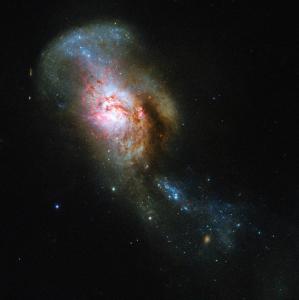Hubble Finds Medusa in the Sky
The galaxy pictured in this Hubble image has an especially evocative name: the Medusa merger.

Hubble Finds Medusa in the Sky
Often referred to by its somewhat drier New General Catalogue designation of NGC 4194, this was not always one entity, but two. An early galaxy consumed a smaller gas-rich system, throwing out streams of stars and dust into space. These streams, seen rising from the top of the merged galaxy, resemble the writhing snakes that Medusa, a monster in ancient Greek mythology, famously had on her head in place of hair, lending the object its intriguing name.
The legend of Medusa also held that anyone who saw her face would transform into stone. In this case, you can feast your eyes without fear on the center of the merged galaxy, a region known as Medusa's eye. All the cool gas pooling here has triggered a burst of star formation, causing it to stand out brightly against the dark cosmic backdrop.
The Medusa merger is located about 130 million light-years away in the constellation of Ursa Major (the Great Bear).
Source: U.S. National Aeronautics and Space Administration
- 300 reads
Human Rights
Fostering a More Humane World: The 28th Eurasian Economic Summi

Conscience, Hope, and Action: Keys to Global Peace and Sustainability

Ringing FOWPAL’s Peace Bell for the World:Nobel Peace Prize Laureates’ Visions and Actions

Protecting the World’s Cultural Diversity for a Sustainable Future

Puppet Show I International Friendship Day 2020

